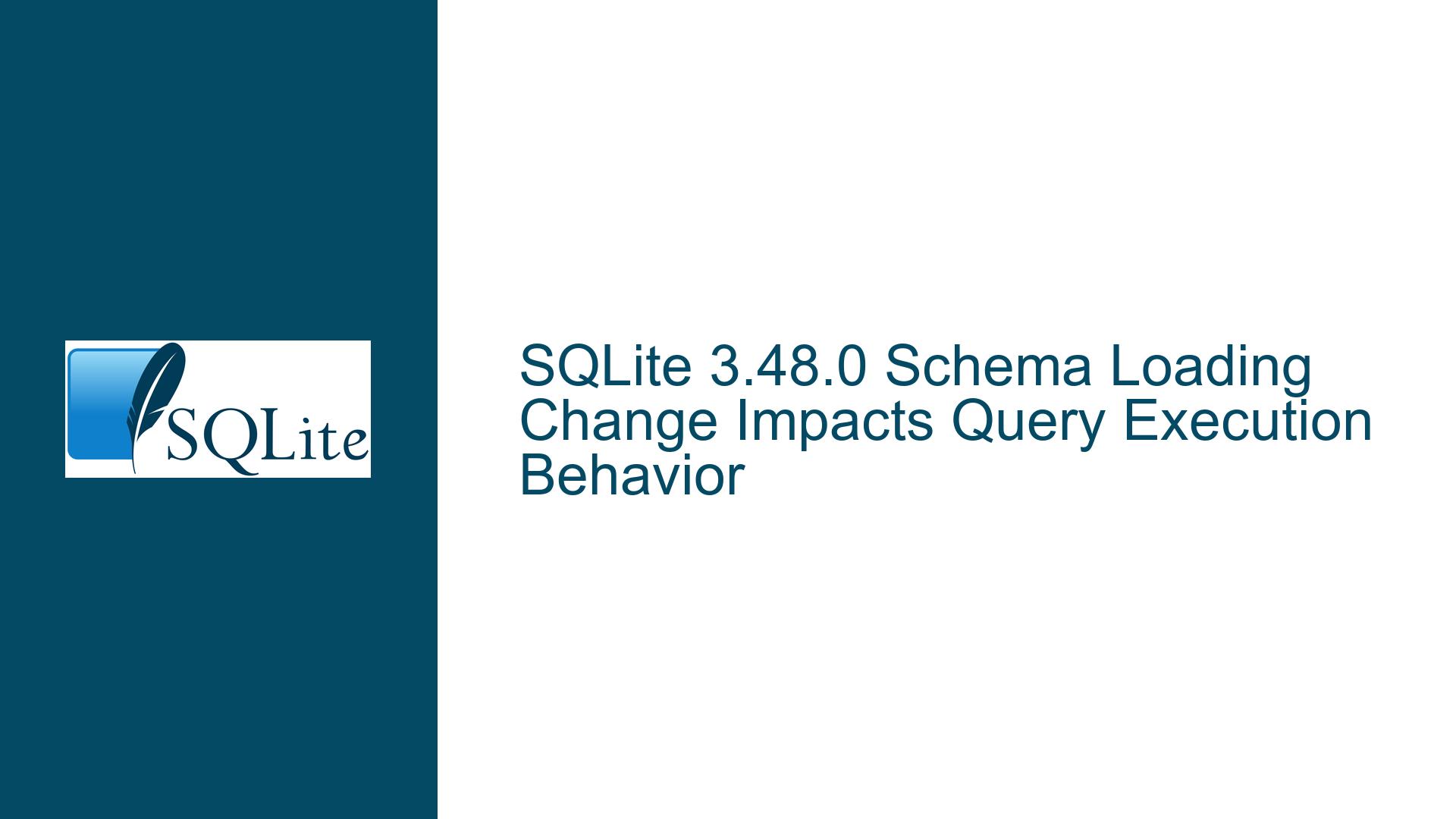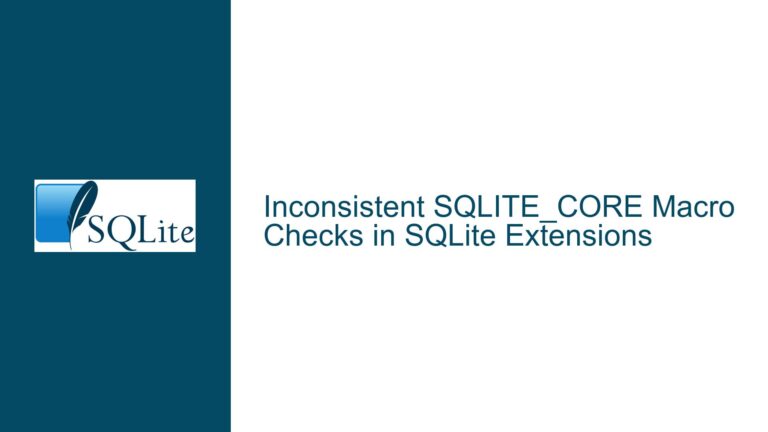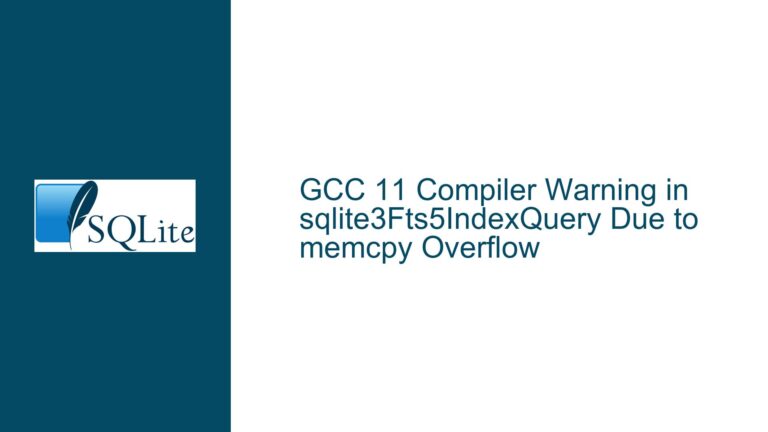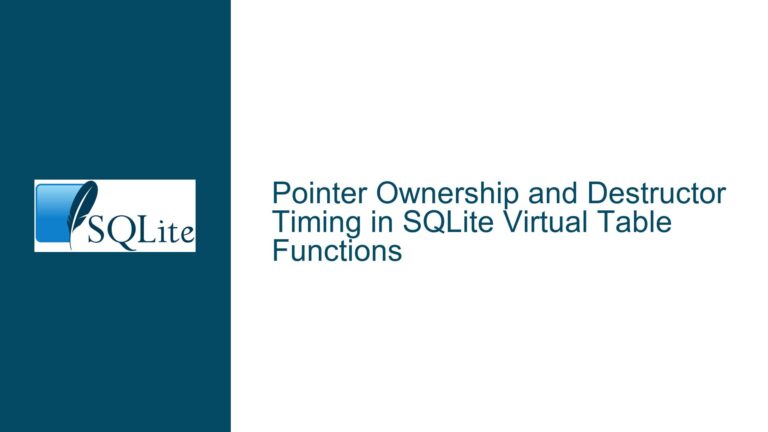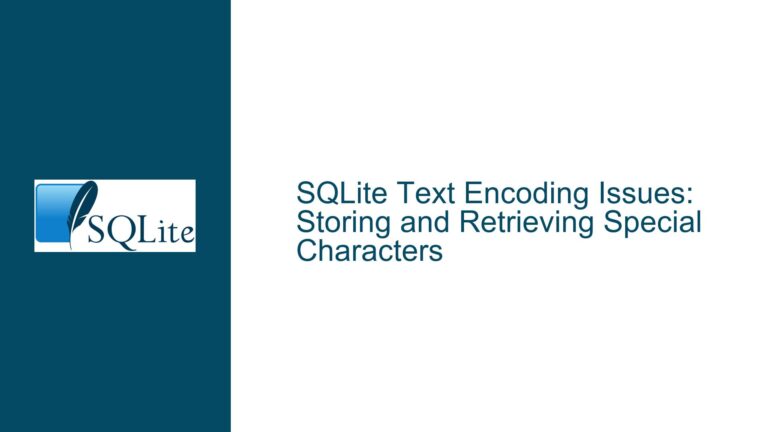SQLite 3.48.0 Schema Loading Change Impacts Query Execution Behavior
Understanding SQLite’s New Schema-First Query Processing Model
SQLite version 3.48.0 introduced a significant architectural change in how the database engine processes queries, even for schema-independent operations. Prior to version 3.48.0, SQLite could execute certain queries without accessing the database file, particularly for operations that didn’t require schema information (like simple arithmetic calculations such as "SELECT 1+2"). This behavior changed fundamentally with the 3.48.0 release, where SQLite now mandatorily reads the database file – specifically the database header and first database page – for all SELECT statements.
This architectural shift represents a departure from SQLite’s previous optimization strategy where schema-independent queries could bypass file system operations entirely. The change affects all query operations, regardless of their complexity or dependency on schema information. For developers and system architects who relied on SQLite’s previous behavior, particularly in scenarios where minimal I/O operations were crucial, this modification requires careful consideration and potential architectural adjustments.
The impact is particularly notable for SQLite extensions and applications that were designed to leverage the previous behavior, where certain operations could be performed without touching the filesystem. These applications might have been optimized around the assumption that simple queries would not trigger file I/O operations, making this change potentially disruptive to existing optimization strategies.
The modification stems from a deliberate design decision, documented in the SQLite source code repository through commit af7173a10e. While this change might seem counterintuitive from a performance optimization standpoint, it aligns with SQLite’s broader architectural goals and maintains consistency in query processing. The new behavior ensures that all queries, regardless of their complexity, follow a uniform processing path through the SQLite engine.
For developers working with SQLite in resource-constrained environments or scenarios where I/O operations need to be minimized, this change necessitates a reevaluation of query processing strategies. The impact is particularly relevant for embedded systems, mobile applications, and other contexts where file I/O operations carry a significant performance cost. Despite SQLite’s continued position as a lightweight database option, this architectural change demonstrates how even seemingly minor version updates can introduce behavioral modifications that affect system design considerations.
The change reinforces SQLite’s commitment to consistent behavior and robust query processing, even if it means sacrificing some optimization opportunities that were previously available. For applications that require schema-independent query processing without file access, developers may need to explore alternative approaches or architectural patterns to achieve their performance goals.
Root Causes Behind Schema Loading Behavior Changes
The schema loading modification in SQLite 3.48.0 stems from several architectural considerations and technical requirements. The mandatory schema loading behavior affects performance in specific scenarios where applications previously relied on schema-independent query optimization.
Performance Impact Factors
Schema loading now requires reading the database header and first database page for all queries, which introduces additional I/O operations. This particularly affects applications designed around minimal filesystem interaction patterns, especially in resource-constrained environments or embedded systems where I/O operations carry significant overhead.
Technical Implementation Details
The schema loading mechanism involves:
| Operation | Impact |
|---|---|
| Database Header Read | Required for all queries |
| First Page Access | Mandatory schema validation |
| Statement Preparation | Additional preprocessing overhead |
Architectural Implications
The change reflects a fundamental shift in SQLite’s query processing model, prioritizing consistency over selective optimization. This architectural decision affects several key areas:
Statement Preparation: Prepared statements must now account for potential schema changes, leading to the "General error: 17 database schema has changed" error if not properly handled.
Query Planning: The query optimizer now has access to complete schema information for all operations, enabling potentially better execution plans but requiring additional resources.
Extension Development: Custom extensions and applications built around the previous behavior need architectural adjustments to accommodate the new schema loading requirements.
Database Design Considerations
Schema management now requires careful attention to:
| Aspect | Consideration |
|---|---|
| Table Design | Optimize for reduced schema complexity |
| Index Strategy | Balance between lookup speed and schema size |
| Query Patterns | Account for mandatory schema loading overhead |
The architectural shift demonstrates SQLite’s evolution toward a more consistent query processing model, though at the cost of some previously available optimization opportunities. This change represents a deliberate design decision to ensure reliable and predictable behavior across all query operations.
Comprehensive Recovery and Prevention Strategies for Schema Loading Issues
Immediate Recovery Methods
The most effective approach for handling schema loading issues involves using SQLite’s built-in recovery mechanisms. The .recover command, introduced in SQLite 3.29.0, provides a robust method for schema restoration. For implementation, execute:
sqlite3 broken.db ".recover" | sqlite3 new.db
Database Integrity Management
Schema corruption requires a systematic approach to restoration and prevention:
| Recovery Phase | Implementation Strategy |
|---|---|
| Schema Backup | Regular schema dumps using PRAGMA table_info |
| Integrity Check | Periodic PRAGMA integrity_check execution |
| Index Validation | REINDEX command for index reconstruction |
Advanced Schema Protection
Schema protection involves implementing multiple safeguards:
PRAGMA journal_mode = WAL;
PRAGMA synchronous = normal;
PRAGMA journal_size_limit = 6144000;
These settings optimize write operations while maintaining schema integrity.
Performance Optimization Techniques
Schema loading performance can be enhanced through strategic indexing and query planning:
| Optimization Area | Implementation Method |
|---|---|
| Index Strategy | Create targeted indexes for frequent schema queries |
| Query Planning | Use EXPLAIN QUERY PLAN for optimization verification |
| Schema Caching | Implement appropriate schema caching mechanisms |
Schema Validation Framework
A comprehensive validation framework should be implemented:
-- Schema validation query
SELECT sql FROM sqlite_master
WHERE type='table' AND name NOT LIKE 'sqlite_%';
-- Index verification
PRAGMA index_list('table_name');
Emergency Recovery Procedures
When schema corruption occurs, follow these technical steps:
-- Step 1: Create schema backup
sqlite3 mydata.db ".dump" > schema_backup.sql
-- Step 2: Analyze corruption
PRAGMA integrity_check;
-- Step 3: Rebuild schema
sqlite3 recovered.db < schema_backup.sql
Schema Monitoring System
Implement continuous schema monitoring:
| Monitoring Aspect | Check Frequency |
|---|---|
| Schema Changes | Every transaction |
| Index Health | Daily verification |
| Integrity Status | Hourly checks |
Prevention Mechanisms
Schema corruption prevention requires implementing several technical safeguards:
-- Enable foreign key constraints
PRAGMA foreign_keys = ON;
-- Set strict table constraints
PRAGMA strict_tables = ON;
-- Enable defensive mode
PRAGMA defensive = ON;
Recovery Optimization
For optimal recovery performance:
| Operation | Technical Implementation |
|---|---|
| Vacuum | Regular database compaction |
| Reindex | Periodic index rebuilding |
| Analyze | Statistics update for query optimization |
Long-term Maintenance
Establish a maintenance routine:
-- Regular maintenance script
PRAGMA wal_checkpoint(FULL);
VACUUM;
ANALYZE;
REINDEX;
This comprehensive approach ensures robust schema management while maintaining optimal performance and data integrity.
